History of PictureGo!
The development of PictureGo! started in 1999. After I had bought my first digital camera, I wrote a program to watch my pictures in a slide show. Being an enthusiastic programmer, I continued to develop the program and version 8.2 is the thirtyninth release, so far....
Version 2.0 - August 2002
A story about developing software, struggling and getting married.
The roots of PictureGo! go back to the summer of 1999. Having an internet girlfriend, I found the perfect excuse to afford the luxury of buying a digital camera. I must have sent her at least 500 pictures in the first couple of months. Whether it helped or not, the fact is that today I can call her my wife!
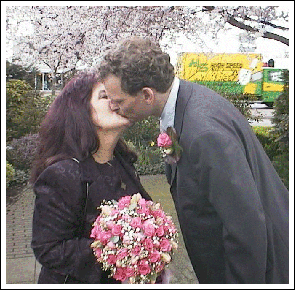
Just married
With a fast growing number of digital pictures on my computer, I felt the need to have a slide show program. Of course, there are a lot of programs available in this category. I myself, wanted something tailor made, a program that simply fulfilled my ideas.
Only a couple of months before that, I purchased a Windows programming package: Delphi 4.0.
I like programming; it is my daily work as well as my hobby.
In developing PictureGo!, I found the perfect combination of learning more on Delphi programming, while making something useful at the same time.
At first I called the program PictureShow! and by March of 2000, version 1.0 had been completed. It was very basic and there were still a lot of issues to work out. But, it met my personal needs; the only thing you had to do was open a folder and start the slide show. From the beginning on that has been the PictureGo! philosophy; start the program and Go!
In those days, I wasn't even thinking of sharing this program with other people. That thought changed in time as I kept making improvements to the program. By the time I finished PictureShow version 1.3, I started to look around on the internet. I found out that PictureShow was a real common name for slide show programs. I changed the name to PictureGo! and baptized it: PictureGo! version 1.0.
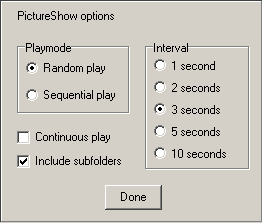
PictureGo 1.0 Options
It was made available through the internet in May 2000. Compared to PictureShow version 1.0, it had advanced quite a few steps. Being still quite simple, I expected the program to be useful to other people.
Making your program available on the internet is one thing, making it noticed in that enormous ocean of information, is a whole different step. It was a struggle for a long period of time; signing up the web site to as many search engines all around the world, trying to get PictureGo! on so called start pages and so on.
Months went by and I still didn't have a single registered user. The first one, after launching version 1.1 in September 2000, did come real unexpectedly. Actually, I had pretty much given up the idea that my program would be of any use to anyone else. It must have been my lucky month. My internet girlfriend, coming from the USA, had moved in with me and I got my first registered PictureGo! user.
Wow, I almost opened a bottle of Champagne! (I hope my wife forgives this comparison!). Only one week later, the second user registered. Then, a wall of silence... Version 1.2 was never made available; version 1.3 was launched in April 2001. It was the first version, that would allow users to put shows together themselves, without being limited to one folder and it's subfolders. The 'breakthrough' (real big word in this respect) came a month later. I managed to get the web site mentioned on 'plaatjes.pagina.nl' (A Dutch start page). The number of hits on the web site increased dramatically. The summit so far came on August 5, 2001. On that day, 5 people registered PictureGo!
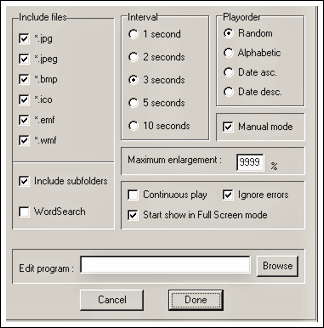
PictureGo 1.3 Options
After the web site disappeared from this start page, the hits on the web site (and subsequently the number of users registering) decreased, but the program kept spreading. In April 2002, I received an email from Paragon Publishing (UK publisher) asking permission to put PictureGo! on their cover mounted CD. I agreed happily and was honored by their request. Humbly I asked for a copy of the particular magazine and CD. I suppose this was just a little too much to ask, since nothing of the kind was delivered to my mailbox. To the defense of Paragon Publishing, I must say that they have been the only ones to ask permission to publish the program; I found out, PictureGo! has appeared on more so-called 'Essential Software' CD-ROM's, but without permission! However, the last couple of months, being an influence of Paragon I suppose, most registered users are of British origin.
The score so far? Some 6000 page hits and 140 registered users. Some 40% out of the Netherlands, the other 60% from places all over the world.
What does this make PictureGo!, a success or a failure? Let me put it this way; I am really glad PictureGo! does not have to pay the gas and electricity bills. Building and maintaining the program is and always will be a hobby, though I really find a lot of satisfaction knowing others appreciate it. That is the kick; after all, the program is not making me any money (okay, I'll be honest, I would not mind making money on PictureGo!).
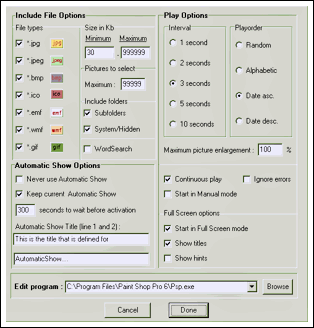
PictureGo 2.0 Options
So, now, August 2002, we reached version 2.0. I could have named it version 1.5, but since the number and nature of changes are vast, version number 2.0 seemed really appropriate. Because of all the changes, this was the first time a PictureGo! test team was installed out of volunteering PictureGo! users. This turned out to be very valuable; a lot of problems were tackled before launching version 2.0. Special thanks in this respect go out to Pieter de Visser, Breda, the Netherlands and Tom McCuen, Long Island, NY, USA, as well as the other members that signed up to the test team. To illustrate some of the changes, this is how the current General options window looks (see image on the right):
Back to my earlier mentioned internet girlfriend (now my wife). Not only did she design the PictureGo! icon, but she is also my editor for the English language used throughout
the program and the web site.
So, what will be next?
Actually I have no idea, we'll let the future take care of that.
Auke Nijholt, the Netherlands, August 2002
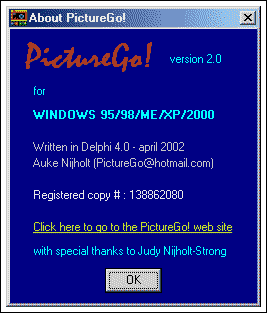
About